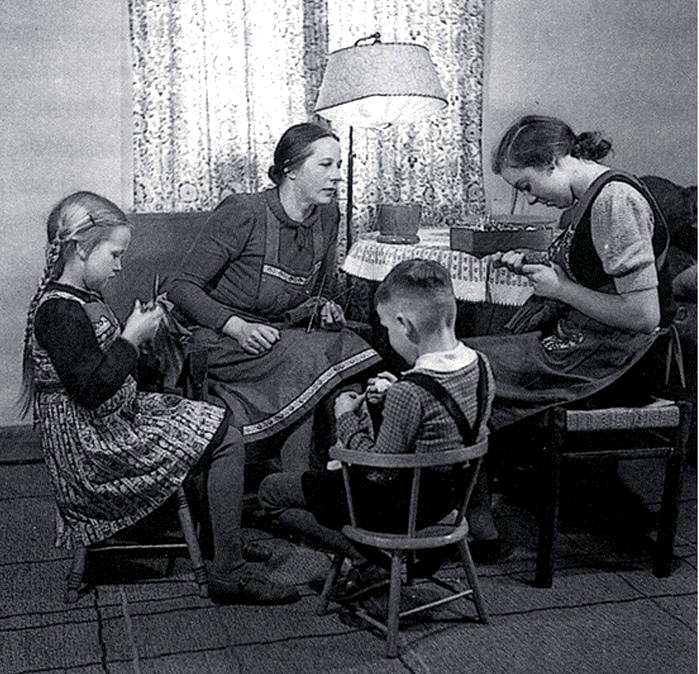
World War II: German Women

Figure 1.--This photograpg probably , taken in Germany at some point during World War II, probably 1942 or 43. It shows a German family engaged in knitting socks for service men at the front. We have the mother left at home with two small children and perhaps a sister or maybe even an elder daughter all engaged in knitting. Notice
that both the boy and the girl are wearing long woolen stockings themselves--very common in Germany during the cooler seasons. A nice domestic scene. They are probably thinking of the man of the family
away at war--possibly on the Eastern front where warm clothing was essential.
|
|
Hitler and the NAZIs thought that women belonged in the home taking care of the husband and the children. This was similar to the pre-NAZI slogan--"Kinder, Küche, Kirche" (children, kitchen, church). It epitomized the NAZI attitude, except for the church element. NAZI ideology saw women as inferior to men. Thus trends like increasing educational and professional achievement were reversed by the NAZIs. The place and duties of married women was primarily to have babies and care for the home. Hitler early in the NAZI era spoke to the National Socialist Women's Organization and insisted for the German woman, her “world is her husband, her family, her children, and her home." (1934) Medals were awarded mothers for child birth. Mothers who had four babies received the Cross of Honor of the German Mother. A major NAZI concern was the falling German birth rate and they did not want to do anything adversely affect the birth rate and domestic life, war being an exception. As a result, German women play a less important role in the War than the women in the Allied countries (America, Britain, and the Soviet Union). Girls and young women were mobilized through the BDM and other NAZI organizations, but The NAZI war effort did not plan for mothers to be taken out of the home to work in factories. German women were not mobilized for War work. At first it was not necessary. The initial victories were reltively easy and did not require the full mobilization of the ecomomy. This changed with Barbarossa, especially after the Red Army offensive before Moscow (December 1941). Rather than mobilize German women, the NAZIs used foreign labor, largely POWs, and slave and other forced labor from the occupied countries to provide needed labor for the War effort. The hard-pressed British in 1939-40 completely reorganized the economy for war production which included the use of large numbers of married women. The Germans did not do this until much later in the War and never extensively mobilized married women. The drafting of me, including middle age men at the end of the War left women in charge of countless German families. Unmarried women did serve as auxiliaries in the military, especially in signals and air defence services. [Williamson] These were non-combat roles except for manning anti-aircraft batteries.
Sources
Williamson, Gordon. World War II German Women’s Auxiliary Services (Osprey, 2003), 48p. This was part of the Osprey 'Men at Arms series'.
CIH -- WW II

Navigate the CIH World War II Section:
[Return to Main German World War II home front page]
[Return to Main country homefront page]
[Return to Main World War II displaced children page]
[About Us]
[Aftermath]
[Biographies]
[Campaigns]
[Children]
[Countries]
[Deciding factors]
[Diplomacy]
[Geo-political crisis]
[Economics]
[Home front]
[Intelligence]
[Military forces]
[POWs]
[Resistance]
[Race]
[Refugees]
[Technology]
[Totalitarian powers]
[Bibliographies]
[Contributions]
[FAQs]
[Images]
[Links]
[Registration]
[Tools]
[Return to Main World War II page]
[Return to Main war essay page]
[Return to CIH Home page]
Created: 6:46 AM 6/7/2007
Last updated: 4:23 PM 6/29/2009



